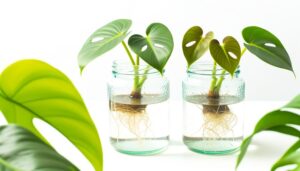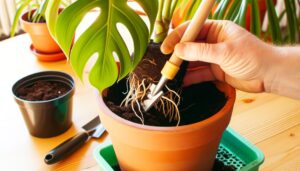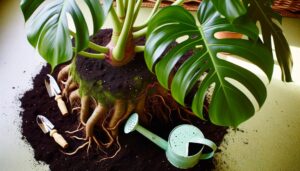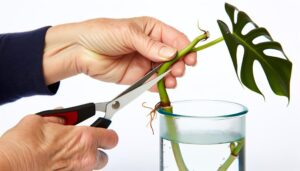How to Propagate Monstera Thai Constellation? Complete Guide
To propagate Monstera Thai Constellation, start by selecting a healthy stem with a 2-inch junction and a 1-inch aerial root. Use sterilized pruning shears to make a 45-degree cut about 1 cm below a node.
Place the cutting in distilled water or a moist substrate like sphagnum moss. Maintain a temperature of 70-75°F and humidity levels around 60-70%.
Guarantee the cutting gets bright, indirect light for 6-8 hours daily. Change the water every 5-7 days to prevent bacterial growth and check for root development after 2-4 weeks.
There’s more to uncover on caring for your new plant successfully.
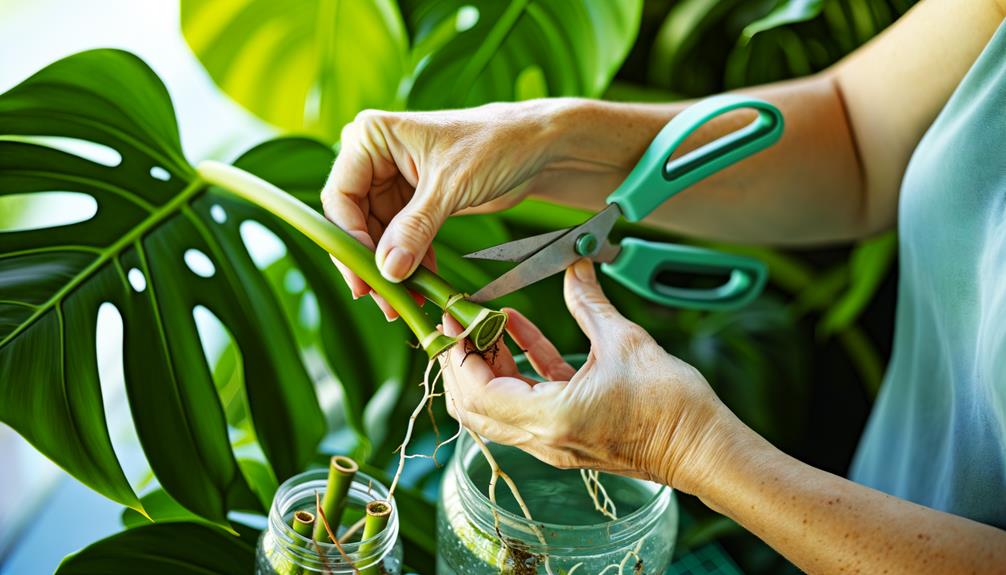
Key Takeaways
- Use clean, sharp pruning shears to make a precise 45-degree cut 1 cm below a node with an aerial root.
- Place the cutting in water or a moist substrate like sphagnum moss, ensuring the node is submerged.
- Maintain bright, indirect light and change water every 5-7 days if using water propagation.
- Use a well-draining soil mix with peat moss and perlite for soil propagation, and keep the node submerged.
- Apply rooting hormone to the cut end to enhance root development and monitor humidity levels around 60-70%.
Gather Your Supplies
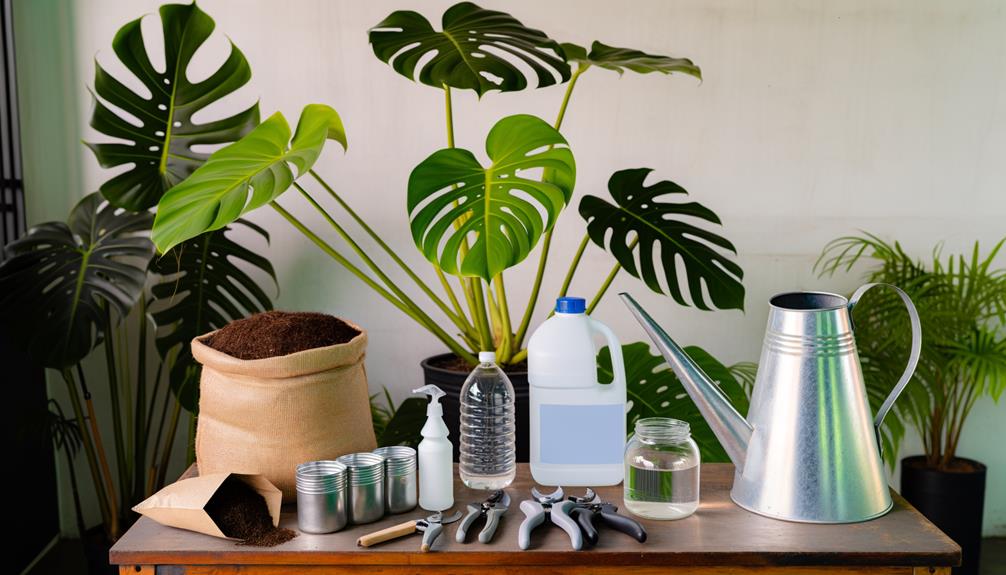
To successfully propagate a Monstera Thai Constellation, you’ll need to gather the following supplies:
- a clean, sharp pair of pruning shears
- a sterile rooting medium
- a clear container for water propagation
- a humidity dome or plastic bag
Ensure your pruning shears are sanitized, as this prevents pathogenic contamination. For the rooting medium, consider using sphagnum moss or perlite, known for their excellent drainage properties.
A clear container, preferably glass, is essential for monitoring root development during water propagation. The humidity dome or plastic bag will help maintain peak humidity levels, around 80%, critical for root initiation and growth.
These supplies, when used correctly, will create an ideal microenvironment for the successful propagation of your Monstera Thai Constellation.
Choose a Healthy Stem
Choose a strong shoot with at least one junction and a healthy aboveground root, maximizing the best chances for successful propagation.
Examine the shoot for any signs of disease or pest infestation. The junction should be at least 2 inches long, and the aboveground root must be firm and approximately 1 inch in length.
Junctions are vital as they contain meristematic cells responsible for root and leaf development. Ensure the shoot exhibits turgor pressure and vibrant coloration, indicative of prime chlorophyll production.
Avoid shoots with mechanical damage or discoloration, as these can compromise the propagation process.
Prepare the Cutting
Guarantee you sterilize your cutting tools with a 70% isopropyl alcohol solution to prevent pathogenic contamination.
Next, identify and select a healthy node with at least one aerial root and leaf for best propagation success.
This node should be free from disease, showing no signs of necrosis or chlorosis.
Sterilize Cutting Tools
Before making any cuts, thoroughly sanitize your cutting tools with a 70% isopropyl alcohol solution to prevent the spread of pathogens. This step is essential for maintaining plant health and guaranteeing successful propagation.
Follow these steps:
- Clean Tools: Remove any visible dirt or plant residue with soap and water.
- Apply Alcohol: Soak a cloth or cotton ball in 70% isopropyl alcohol and wipe down the blade entirely.
- Dry Properly: Allow the tool to air-dry completely to make sure the alcohol has evaporated.
- Repeat Process: Sterilize the tools again if making multiple cuts to maintain sterility.
Using sanitized tools minimizes the risk of bacterial or fungal infections, promoting healthier plant growth.
Select Healthy Node
Identify a sturdy node on the Monstera Thai Constellation, characterized by the presence of a healthy aerial root and at least one mature leaf.
Select a node exhibiting a strong, turgid aerial root approximately 2-3 centimeters in length. Make sure the leaf attached to the node is free from chlorosis, necrosis, or pest damage, as these indicators reflect the overall health of the cutting.
Use a sharp, sterilized blade to make a precise incision about 1 centimeter below the selected node. Avoid crushing or damaging the surrounding tissue to prevent infection.
Immediately place the cutting in a clean container with water or a moist substrate. This guarantees ideal conditions for the cutting to establish roots, facilitating successful propagation.
Make the Cut
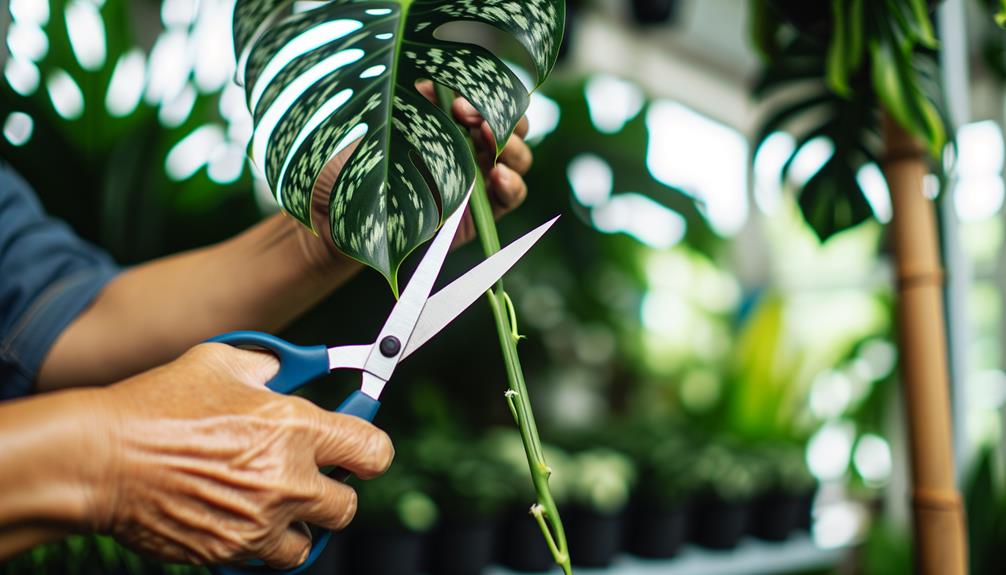
- When making the cut, select a node that has at least one aerial root for best growth.
- Use sterile cutting tools, such as a scalpel or pruning shears, to prevent contamination.
- Make a precise incision at a 45-degree angle, approximately 1 centimeter below the node.
Select Optimal Cutting Spot
Identify a leaf node that has at least one healthy aerial root, guaranteeing the cutting will have the best chance for successful propagation.
Examine the Monstera Thai Constellation‘s stem and locate a node with a well-developed aerial root system. These roots appear as small, brownish, and fibrous protrusions.
Measure 1-2 inches below this node, as this will be your cutting point. This distance ensures that the node remains intact while providing enough stem length for water absorption and nutrient uptake.
Avoid choosing nodes with signs of disease or damage, like black spots or mushy texture.
A healthy node with robust aerial roots significantly enhances the likelihood of successful rooting and growth in the propagation process.
Use Sterile Cutting Tools
Maintain the sterility of your cutting tools by thoroughly disinfecting them with a solution of 70% isopropyl alcohol or a diluted bleach mixture, reducing the risk of pathogen transmission to the Monstera Thai Constellation.
To prepare the solution, mix one part bleach with nine parts water. Immerse your pruning shears, scissors, or knife in the solution for at least 5 minutes.
Alternatively, you can wipe the blades with a cloth soaked in 70% isopropyl alcohol. This sterilization process guarantees that bacteria, fungi, and viruses don’t contaminate the plant tissue.
Make Precise Incision
To make the cut, position your sterilized tool just below a node, making sure the incision is clean and angled at around 45 degrees. This technique maximizes surface area for root development and minimizes potential harm to the plant tissue.
When making the incision, make sure the following:
- Sterility: Use ethanol or isopropyl alcohol (70%) to sanitize your cutting instrument.
- Angle: Maintain a 45-degree slant to increase rooting surface area.
- Proximity: Cut approximately 0.5 cm below the node for prime nutrient uptake.
- Precision: Ensure the cut is smooth and clean to prevent pathogen entry.
Adhering to these parameters will improve the likelihood of successful propagation and healthy new growth from your Monstera Thai Constellation cuttings.
Rooting in Water
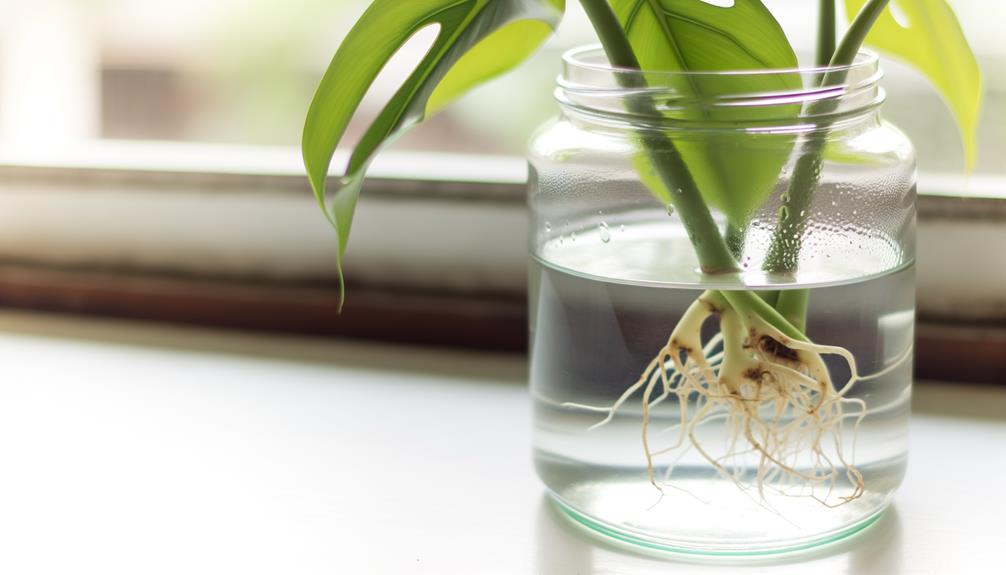
To successfully root your Monstera Thai Constellation in water, submerge the cut end of the stem in a transparent container filled with distilled water, ensuring the node is fully covered. Maintain water levels so the node remains submerged, and change the water every 5-7 days to prevent bacterial growth.
Place the container in a location with bright, indirect sunlight. Monitor root development, which typically begins within 2-4 weeks.
- Water Quality: Use distilled water to prevent mineral buildup.
- Light Exposure: Provide bright, indirect sunlight to stimulate root growth.
- Water Change: Replace water every 5-7 days to maintain hygiene.
- Root Inspection: Check for root initiation after 2-4 weeks, looking for white rootlets.
Rooting in Soil
If you prefer soil propagation, start by preparing a well-aerated potting mix composed of 50% peat moss and 50% perlite. This mixture ensures ideal drainage and aeration, crucial for root development. Select a sterile container with drainage holes to prevent waterlogging.
Insert the Monstera cutting into the mix, making sure at least one node is submerged in the soil. Apply gentle downward pressure to secure the cutting.
Maintain an ambient temperature of 70-75°F (21-24°C) and provide indirect sunlight to facilitate photosynthesis without scorching the leaves. Use a humidity dome or plastic bag to create a microenvironment with 60-70% humidity, promoting root growth.
Periodically check the cutting for signs of root development and new growth.
Monitor Moisture Levels

Regularly check the soil moisture by inserting a hygrometer or using the finger test to confirm it stays consistently moist but not waterlogged. Maintaining ideal moisture levels is important for healthy root development. Aim for a soil moisture content of around 40-50%.
Avoid overwatering, as excess moisture can lead to root rot and fungal diseases.
- Hygrometer Use: Insert a hygrometer 2-3 inches into the soil. Ideal readings should be between 4-6 on the moisture scale.
- Finger Test: Insert your finger into the soil up to the first knuckle. The soil should feel damp but not soggy.
- Watering Frequency: Water when the top 2 inches of soil feel dry.
- Drainage: Guarantee the pot has sufficient drainage holes to prevent water accumulation.
Monitoring moisture accurately ensures a thriving Monstera Thai Constellation.
Provide Adequate Light
Ensuring your Monstera Thai Constellation receives bright, indirect light for 6-8 hours daily is crucial for best photosynthesis and growth. Position your plant near an east-facing window where it can benefit from morning sunlight without exposure to intense, direct rays.
Alternatively, a north-facing window can provide consistent illumination. Avoid placing the plant in direct sunlight, as this can lead to photoinhibition and chlorophyll degradation, which impairs growth.
Utilize a light meter to measure light intensity, aiming for 10,000 to 20,000 lux. If natural light is insufficient, use full-spectrum LED grow lights, positioned 12-18 inches from the foliage. Monitor light conditions regularly to ensure they remain within peak parameters, promoting robust development and variegation retention.
Transplanting Your Cutting
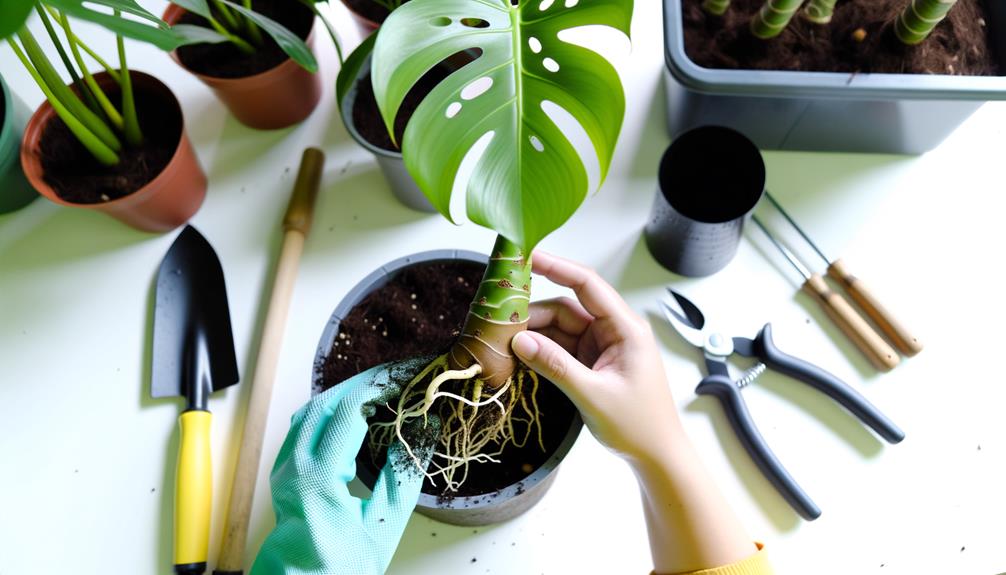
When transplanting your Monstera Thai Constellation cutting, start by preparing a well-draining soil mix with a pH of 5.5-6.5.
Apply a rooting hormone to the cut end to enhance root development.
Position the pot in an area with indirect sunlight, maintaining a temperature range of 20-25°C.
Preparing the Soil
To prepare the soil for transplanting your Monstera Thai Constellation cutting, use a well-draining mix comprising 40% orchid bark, 30% perlite, and 30% high-quality potting soil. This mixture guarantees optimal aeration and moisture retention, essential for root development.
Follow these steps:
- Mix Proportions: Combine 4 parts orchid bark, 3 parts perlite, and 3 parts potting soil in a clean container.
- Sterilization: Sterilize the mix by baking it at 180°F (82°C) for 30 minutes to eradicate pathogens.
- pH Testing: Confirm the soil pH is between 5.5 and 6.5 using a pH meter.
- Moisture Level: Dampen the mix slightly before planting to encourage immediate root contact.
Adhering to these guidelines will establish a strong foundation for your cutting.
Rooting Hormone Application
After preparing the soil, apply a high-quality rooting hormone to the cut end of your Monstera Thai Constellation cutting to expedite root development and increase the chances of successful propagation.
Dip the freshly cut end of the stem into the rooting hormone powder or gel, ensuring it covers at least 2 centimeters of the cut surface. The auxins in the rooting hormone, such as Indole-3-butyric acid (IBA), will stimulate root cell differentiation and elongation. Gently tap off excess hormone to avoid clumping, which could hinder root formation.
Immediately insert the treated cutting into the pre-moistened soil, ensuring it’s 5-7 centimeters deep. Firm the soil around the base to provide stability and favorable contact for root emergence.
Pot Placement Tips
Positioning your Monstera Thai Constellation cutting in a location that receives bright, indirect light is essential for optimal photosynthesis and healthy root development.
You must make sure that the pot is placed in an area with a consistent temperature range of 18-24°C (65-75°F) to maximize growth. Avoid direct sunlight, which can harm the delicate leaves.
To further enhance growth conditions, follow these guidelines:
- Humidity Levels: Maintain ambient humidity around 60-70% to mimic its natural tropical environment.
- Air Circulation: Position the pot where there’s good air circulation but avoid drafty windows or vents.
- Elevation: Raise the pot slightly to guarantee proper drainage and prevent root rot.
- Watering Schedule: Water the cutting when the top 2-3 cm (1 inch) of soil feels dry to the touch.
Care for New Plants
Ensuring prime care for new Monstera Thai Constellation plants involves maintaining a consistent humidity level of around 60-70% and providing indirect, bright light to promote healthy growth. Make sure the temperature remains between 20-25°C. Water the soil when the top inch feels dry. Use a balanced fertilizer every 4-6 weeks to support nutrient uptake.
| Factor | Ideal Range | Notes |
|---|---|---|
| Humidity | 60-70% | Use a humidifier if needed |
| Light | Indirect, Bright | Avoid direct sunlight |
| Temperature | 20-25°C | Consistent temperature |
| Watering | When top inch is dry | Ensure good drainage |
Regularly inspect for pests and prune any dead or damaged leaves to maintain plant health.
Conclusion
By following these steps—gathering your supplies, choosing a healthy stem, making the cut, preparing the cutting, rooting in water, monitoring moisture levels, providing adequate light, and transplanting your cutting—you’ll guarantee successful propagation of your Monstera Thai Constellation.
Consistent care, attention to detail, and precise techniques will yield healthy new plants. Remember, propagation isn’t just a process; it’s an investment in plant health, growth, and longevity.
Happy propagating!

